Comparative Study of the Cross-Flow Heat and Mass Exchangers for Indirect Evaporative Cooling Using Numerical Methods
Abstract
:1. Introduction
2. Description of the Regenerative and Conventional Cross-Flow HMXs
3. Simulation Method
- (1)
- The heat and mass transfer in the HMXs is in steady state, and no heat exchange occurs between the HMXs and ambience.
- (2)
- The direction of heat transfer between dry channels and wet channels is perpendicular to the plate wall.
- (3)
- The water film in the wet channel is uniformly distributed on the surface of the plate wall, and the water temperature is constant. difference in temperature;
- (4)
- The temperature difference on both sides of the plate wall is ignored.
- (5)
- The temperatures of air and water in the HMXs only change along the flow direction.
4. Computer Model Validation
5. Results and Discussion
5.1. General Comparison
5.2. Heat and Mass Transfer Analysis
5.3. Impact of Intake Air Parameters
5.3.1. Impact of Intake Air Temperature
5.3.2. Impact of Intake Air Moisture Content
5.3.3. Impact of Supply Air Flow Rate
6. Conclusions
- (1)
- Under the typical operating parameters shown in Table 1, the cooling capacity of the regenerative HMX is 20.1% higher than that of the conventional HMX. When the supply air flow rate increases from 300 m3/h to 3000 m3/h and the other parameters remain unchanged, the cooling capacity of the conventional HMX is 9.7% higher than that of the regenerative HMX.
- (2)
- More sufficient pre-cooling of the dry channel air and higher flow rate of the supply air lead to better cooling performance of the regenerative HMX. When the intake temperature of the dry channel air is 26 °C, the supply air flow rate is 3000 m3/h, and the other parameters remain at the values shown in Table 1, the cooling capacity of the cross-flow regenerative HMX is 42.4% higher than that of the conventional cross-flow HMX.
- (3)
- When both the HMXs are used alone, the cooling performance of the regenerative HMX is better than that of the conventional HMX in the case of low supply air flow rate. When they are used in the multistage evaporative cooling systems with high supply air flow rate, the conventional HMX is more suitable as the first stage of the system to pre-cool the supply air, while the regenerative HMX is more suitable as the second stage to re-cool the supply air.
Author Contributions
Funding
Conflicts of Interest
Nomenclature
| A | heat transfer area, m2 |
| cp | specific heat, kJ/kg °C |
| d | moisture content, kg/kg |
| h | convection coefficient, W/ (m2 °C) |
| hm | mass transfer coefficient, m/s |
| i | enthalpy, kJ/kg |
| L | length, m |
| m | air mass flow rate, kg/s |
| rw | vaporization heat, kJ/kg |
| T | temperature, °C |
| De | equivalent diameter, m |
| Le | Lewis number |
| Nu | Nusselt number |
| Pr | Prandtl number |
| Re | Reynolds number |
| Greek | |
| ρ | Density, kg/m3 |
| μ | dynamic viscosity, N∙s/m2 |
| Subscripts | |
| l | latent heat |
| w | wall |
| 1 | dry side |
| 2 | wet side |
References
- Chua, K.J.; Chou, S.K.; Yang, W.M.; Yan, J. Achieving better energy-efficient air conditioning—A review of technologies and strategies. Appl. Energy 2013, 104, 87–104. [Google Scholar] [CrossRef]
- Zimmermann, M.; Remund, S. IEA-ECBCS Annexure 28 Subtask 2, Ground Coupled Air Systems. In Low Energy Cooling-Technology Selection and Early Design Guidance; Barnard, N., Jaunzens, D., Eds.; Construction Research Communications: Ellesmere Port, UK, 2001; pp. 95–109. [Google Scholar]
- Behne, M. Alternatives to Compressive Cooling in Non-Residential Buildings to Reduce Primary Energy Consumption; Final Report; Lawrence Berkeley National Laboratory: Berkeley, CA, USA, 1997.
- Sultan, M.; El-Sharkawy, M.; Miyazaki, T.; Saha, B.B.; Koyama, S. An overview of solid desiccant dehumidification and air conditioning systems. Renew. Sustain. Energy Rev. 2015, 46, 16–29. [Google Scholar] [CrossRef]
- Steven, B.J.; Domanski, P.A. Review of alternative cooling technologies. Appl. Therm. Eng. 2014, 64, 252–262. [Google Scholar] [CrossRef]
- Duan, Z.; Zhan, C.; Zhang, X.; Mustafa, M.; Zhao, X.; Alimohammadisagvand, B.; Hasan, A. Indirect evaporative cooling: Past, present and future potentials. Renew. Sustain. Energy Rev. 2012, 16, 6823–6850. [Google Scholar] [CrossRef]
- Huang, X. Evaporative Air Conditioning Theory and Application; China Building Industry Press: Beijing, China, 2010; pp. 100–110. ISBN 9787112121953. (In Chinese) [Google Scholar]
- Maisotsenko, V.S.; Gillan, L.E.; Heaton, T.L.; Gillan, A.D. Method and Plate Apparatus for Dew Point Evaporative Cooler. US Patent No. US6581402, 24 June 2003. [Google Scholar]
- Zhan, C.; Zhao, X.; Smith, S.; Riffat, S.B. Numerical study of a M-cycle cross-flow heat exchanger for indirect evaporative cooling. Build. Environ. 2011, 46, 657–668. [Google Scholar] [CrossRef]
- Mahmood, M.H.; Sultan, M.; Miyazaki, T.; Koyama, S.; Maisotsenko, V.S. Overview of the Maisotsenko cycle—A way towards dew point evaporative cooling. Renew. Sustain. Energy Rev. 2016, 66, 537–555. [Google Scholar] [CrossRef]
- Bruno, F. On-site experimental testing of a novel dew point evaporative cooler. Energy Build. 2011, 43, 3475–3483. [Google Scholar] [CrossRef]
- Riangvilaikul, B.; Kumar, S. An experimental study of a novel dew point evaporative cooling system. Energy Build. 2010, 42, 637–644. [Google Scholar] [CrossRef]
- Duan, Z.; Zhan, C.; Zhao, X.; Dong, X. Experimental study of a counter-flow regenerative evaporative cooler. Build. Environ. 2016, 104, 47–58. [Google Scholar] [CrossRef]
- Xu, P.; Ma, X.; Zhao, X.; Fancey, K. Experimental investigation of a super performance dew point air cooler. Appl. Energy 2017, 203, 761–777. [Google Scholar] [CrossRef]
- Antonellis, S.D.; Joppolo, C.M.; Liberati, P.; Milani, S.; Molinaroli, L. Experimental analysis of a cross flow indirect evaporative cooling system. Energy Build. 2011, 121, 130–138. [Google Scholar] [CrossRef]
- Kim, H.J.; Ham, S.W.; Yoon, D.S.; Jeong, J.W. Cooling performance measurement of two cross-flow indirect evaporative coolers in general and regenerative operation modes. Appl. Energy 2017, 195, 268–277. [Google Scholar] [CrossRef]
- Zhao, X.; Li, J.; Riffat, S.B. Numerical study of a novel counter-flow heat and mass exchanger for dew point evaporative cooling. Appl. Therm. Eng. 2008, 28, 1942–1951. [Google Scholar] [CrossRef]
- Zhan, C.; Duan, Z.; Zhao, X. Comparative study of the performance of the M-cycle counter-flow and cross-flow heat exchangers for indirect evaporative cooling—Paving the path toward sustainable cooling of buildings. Energy 2011, 36, 6790–6805. [Google Scholar] [CrossRef]
- Bolotin, S.; Vager, B.; Vasilijev, V. Comparative analysis of the cross-flow indirect evaporative air coolers. Int. J. Heat Mass Transfer. 2015, 88, 224–235. [Google Scholar] [CrossRef]
- Riangvilaikul, B.; Kumar, S. Numerical study of a novel dew point evaporative cooling system. Energy Build. 2010, 42, 2241–2250. [Google Scholar] [CrossRef]
- Lin, J.; Thu, K.; Bui, T.; Wang, R.; Ng, K.C.; Chua, K.J. Study on dew point evaporative cooling system with counter-flow configuration. Energy Convers. Manag. 2016, 109, 153–165. [Google Scholar] [CrossRef]
- Xu, P.; Ma, X.; Diallo, T.M.O.; Zhao, X.; Fancey, K.; Li, D.; Chen, H. Numerical investigation of the energy performance of a guideless irregular heat and mass exchanger with corrugated heat transfer surface for dew point cooling. Energy 2016, 109, 803–817. [Google Scholar] [CrossRef]
- Hasan, A. Going below the wet-bulb temperature by indirect evaporative cooling: Analysis using a modified e-NTU method. Appl. Energy 2012, 89, 237–245. [Google Scholar] [CrossRef]
- Liu, Z.; Allen, W.; Modera, M. Simplified thermal modeling of indirect evaporative heat exchangers. HVACR Res. 2013, 19, 257–267. [Google Scholar] [CrossRef]
- Hasan, A. Indirect evaporative cooling of air to a sub-wet bulb temperature. Appl. Therm. Eng. 2010, 30, 2460–2468. [Google Scholar] [CrossRef]
- Cui, X.; Chua, K.J.; Islam, M.R.; Yang, W.M. Fundamental formulation of a modified LMTD method to study indirect evaporative heat exchangers. Energy Convers. Manag. 2014, 88, 372–381. [Google Scholar] [CrossRef]
- Hsu, S.T.; Lavan, Z.; Worek, W.M. Optimization of wet-surface heat exchangers. Energy 1989, 14, 757–770. [Google Scholar] [CrossRef]
- Yang, S.; Tao, W. Heat Transfer, 4th ed.; Higher Education Press: Beijing, China, 2006; pp. 229–280. ISBN 9787040189186. (In Chinese) [Google Scholar]
- Qiu, G. A Novel Evaporative/Desiccant Cooling System. Ph.D. Thesis, The University of Nottingham, Nottingham, UK, 2007. [Google Scholar]

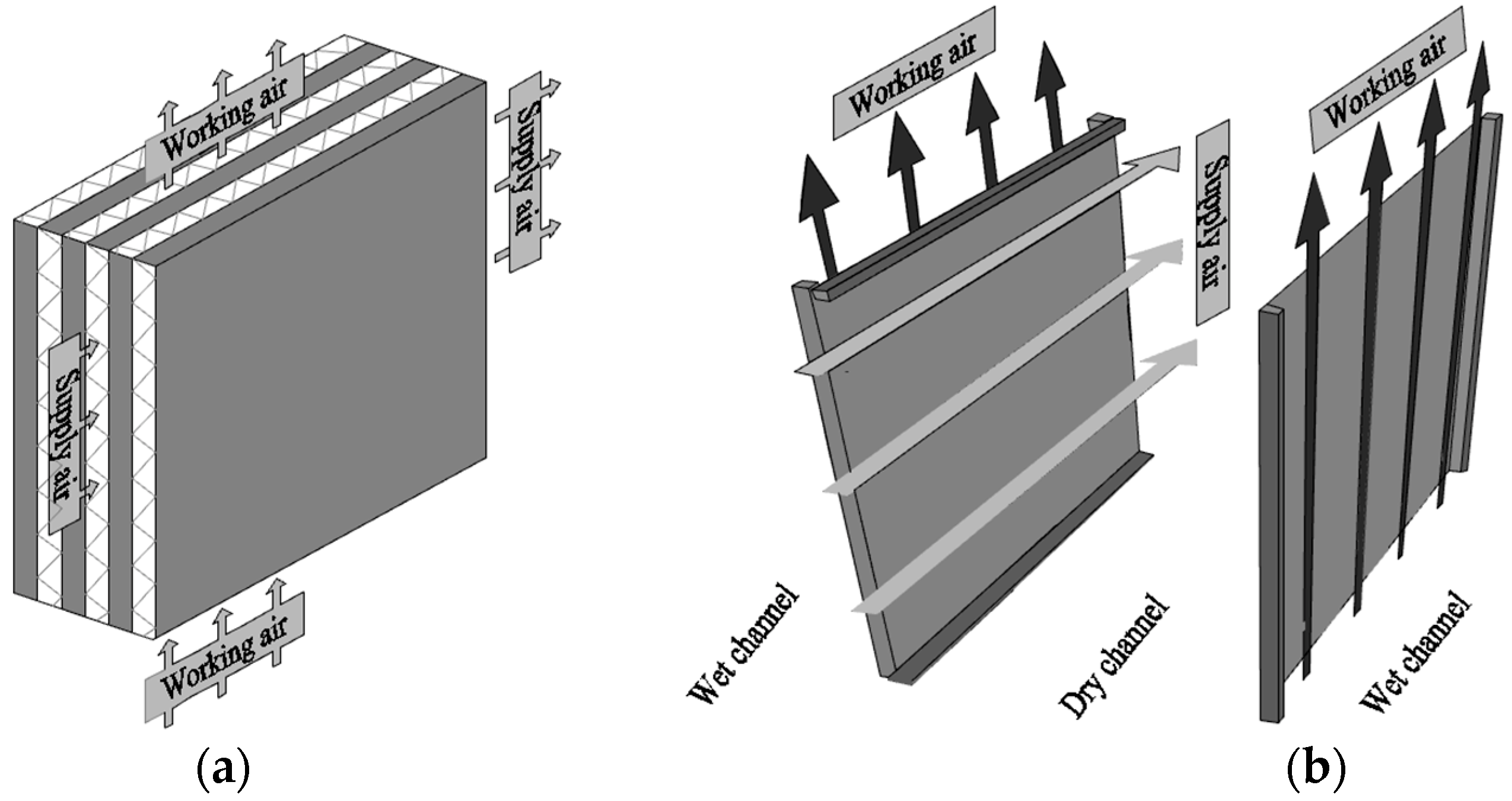




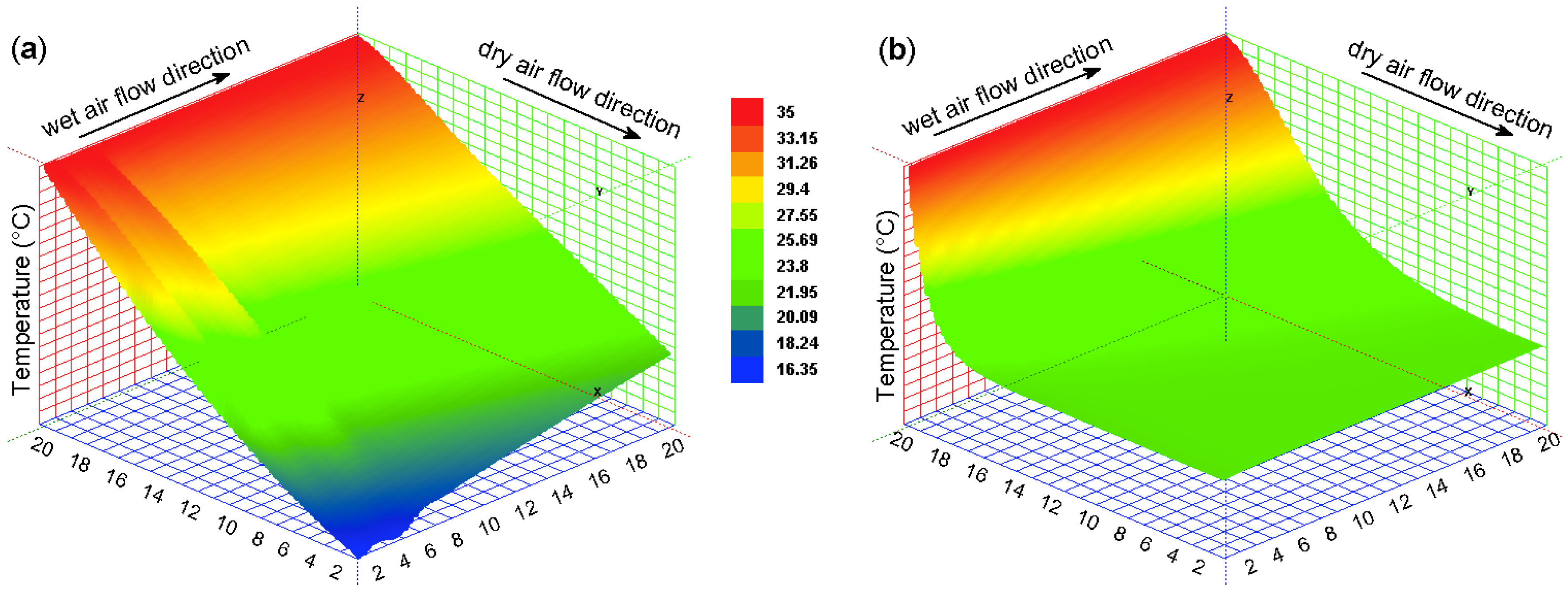
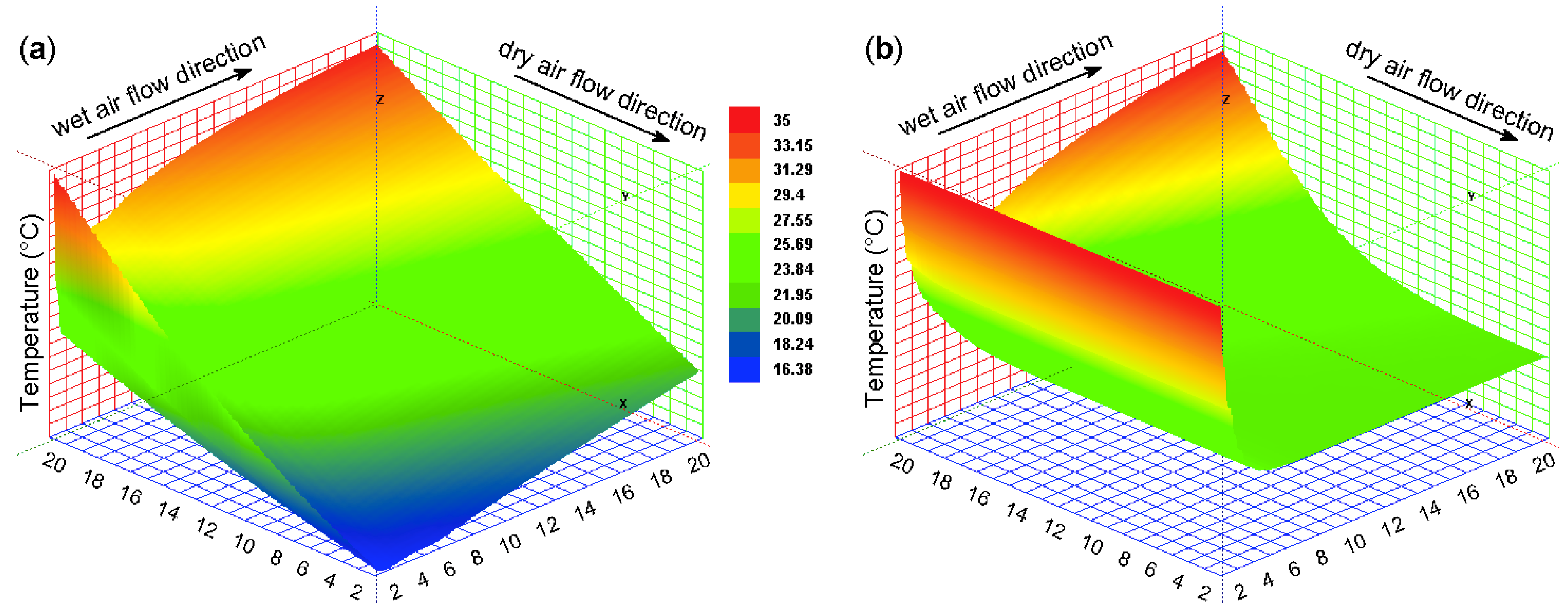

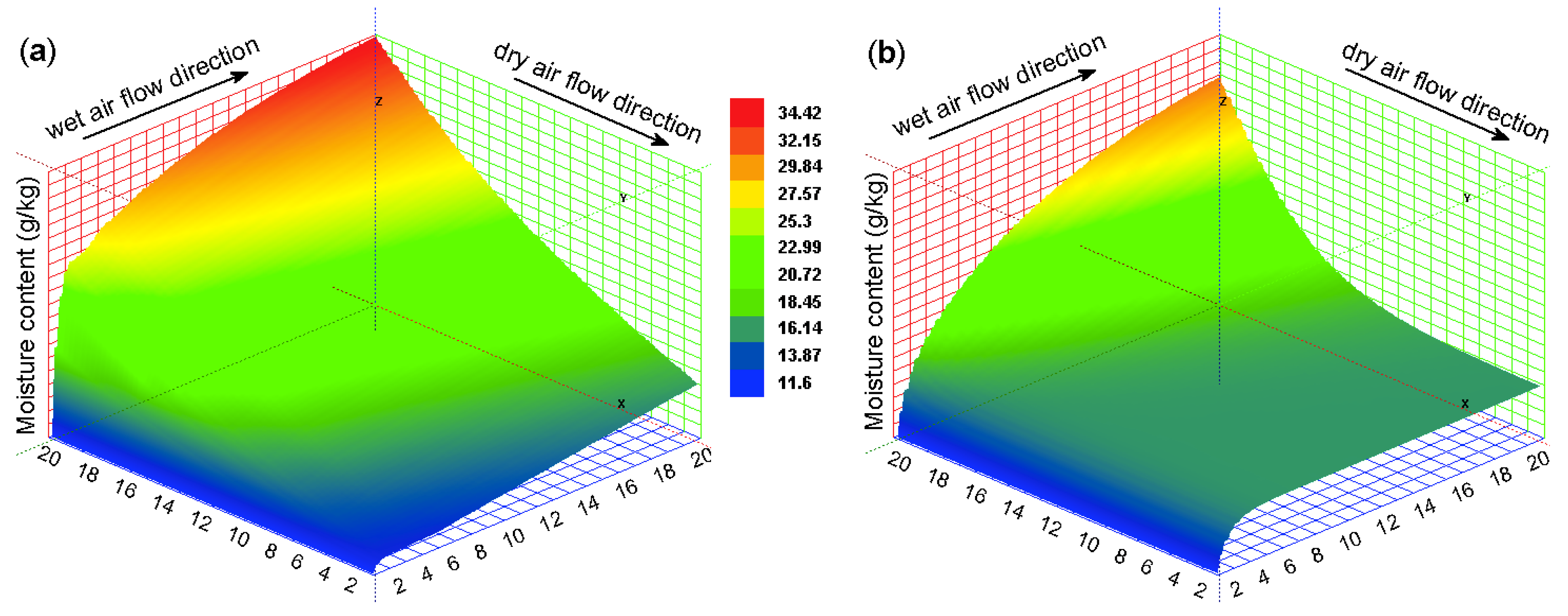

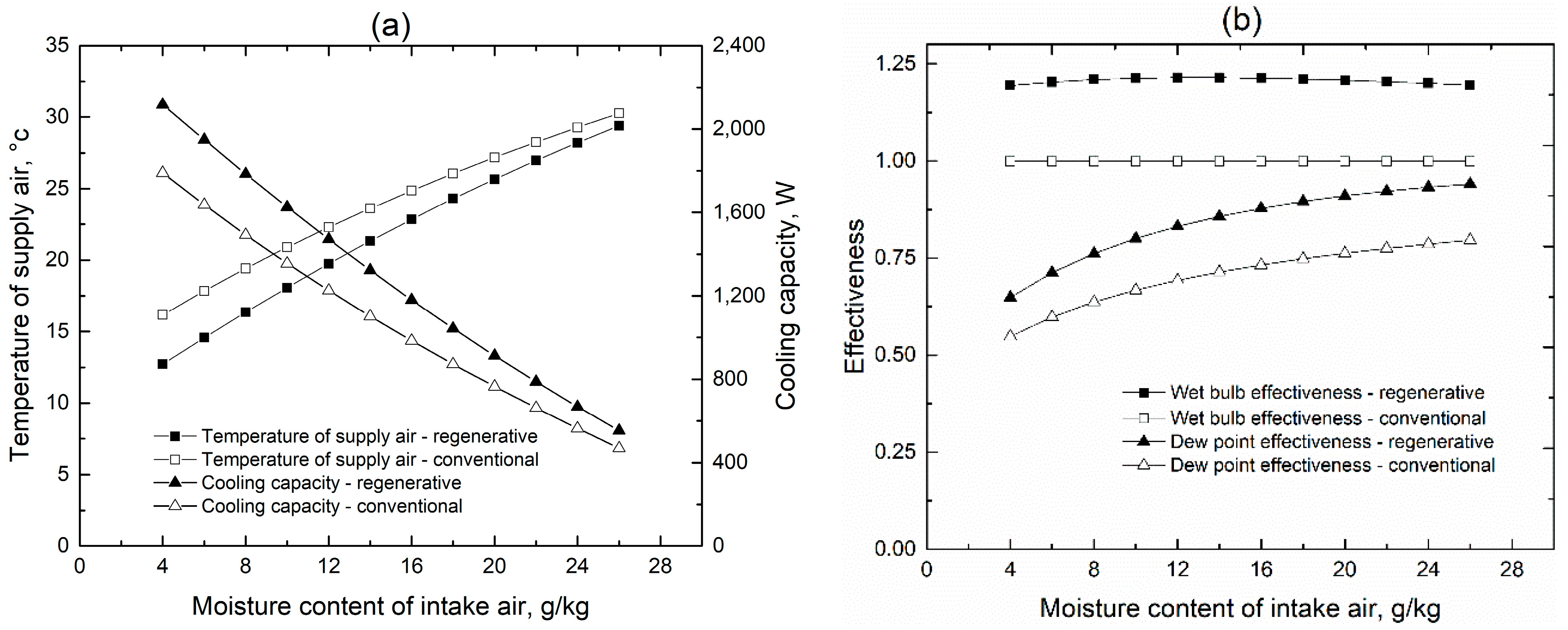
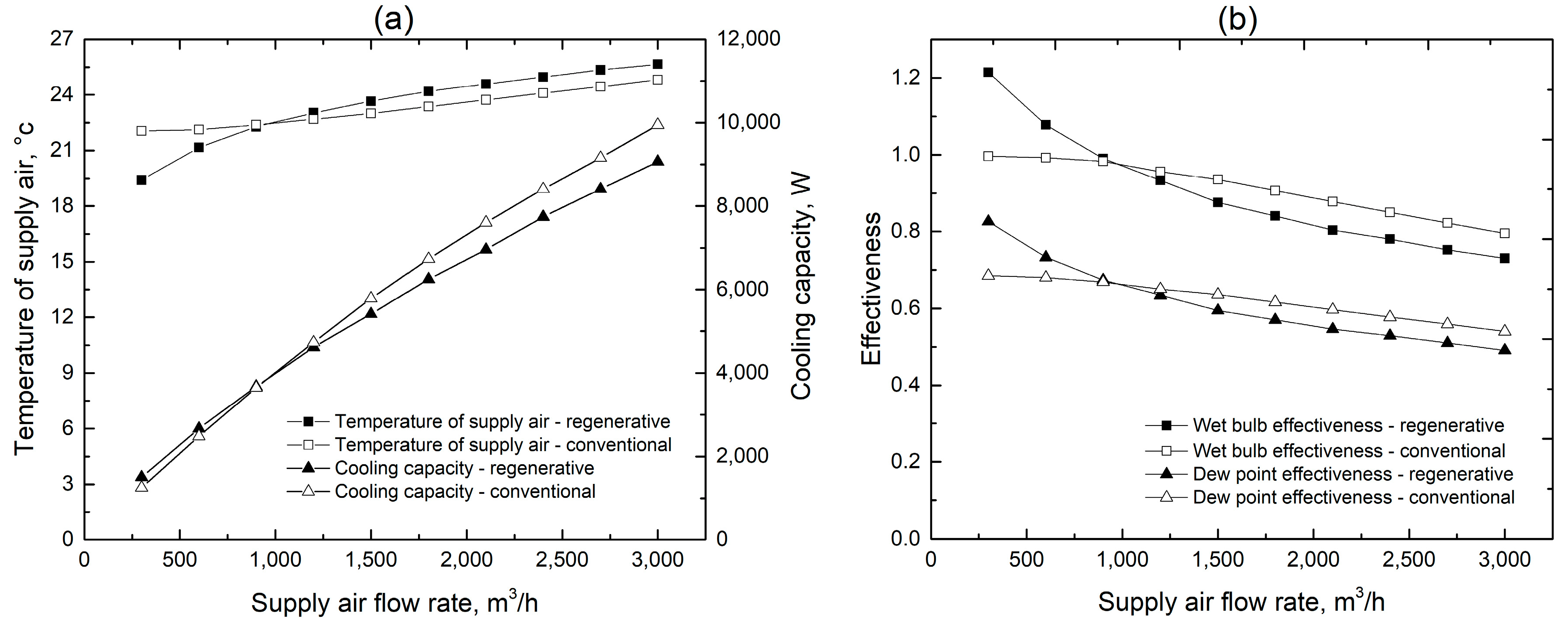
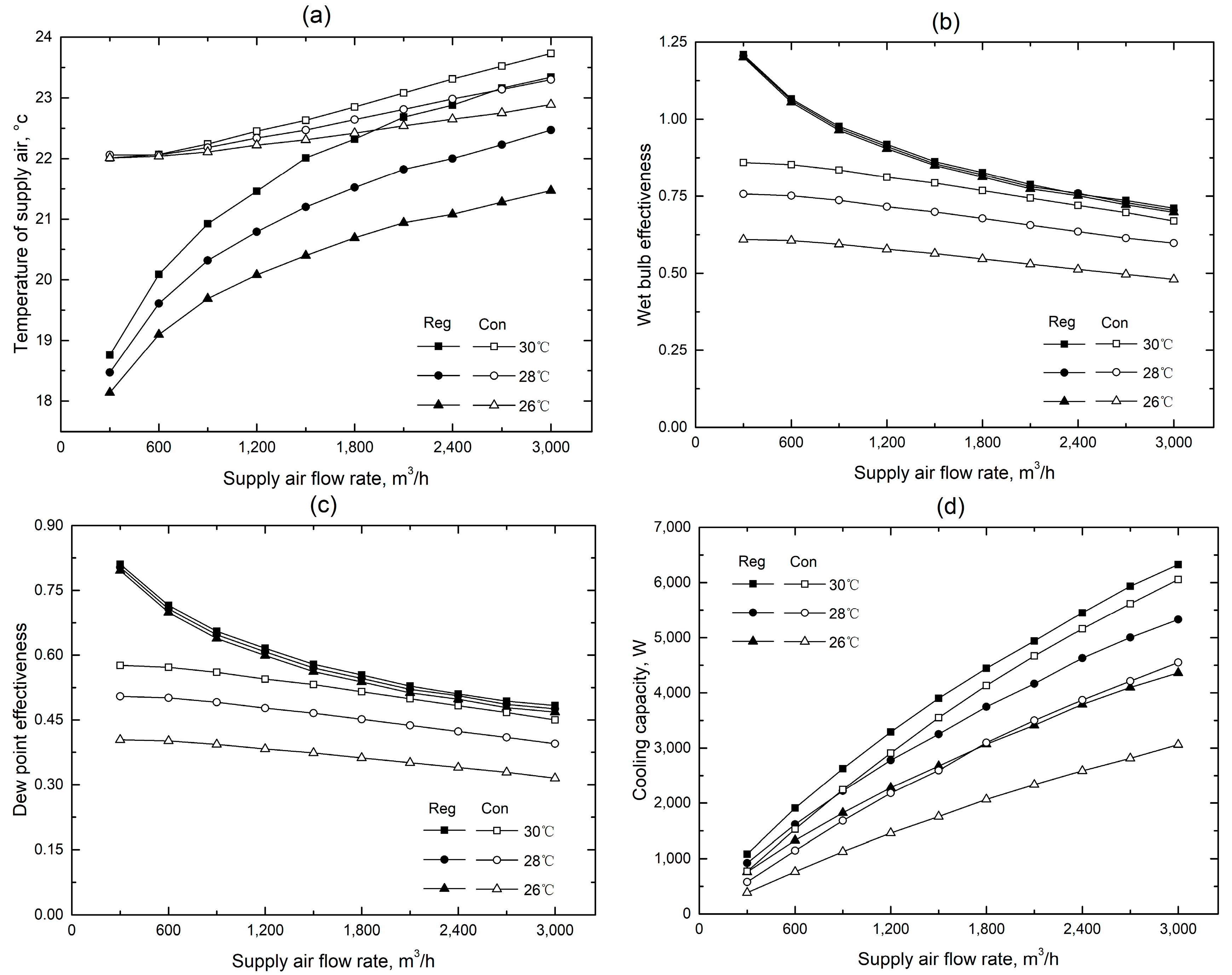
| Parameters | Value |
|---|---|
| Intake air temperature (°C) | 35 |
| Moisture content (g/kg) | 11.3 |
| Working to supply air ratio | 1 |
| Supply air flow rate (m3/h) | 300 |
| Channel height (m) | 0.004 |
| HMX length/width (m) | 1.2 |
| Working to supply air area ratio * | 1.25 |
| Channels number | 184 |
| Parameters | Regenerative HMX | Conventional HMX |
|---|---|---|
| Supply air temperature (°C) | 19.4 | 22 |
| Relative humidity of supply air (%) | 81.5 | 69.1 |
| Wet bulb effectiveness (%) | 121.5 | 99.9 |
| Dew point effectiveness (%) | 82.6 | 68.7 |
| Cooling capacity (W) | 1503 | 1251 |
© 2018 by the authors. Licensee MDPI, Basel, Switzerland. This article is an open access article distributed under the terms and conditions of the Creative Commons Attribution (CC BY) license (http://creativecommons.org/licenses/by/4.0/).
Share and Cite
Wang, Y.; Huang, X.; Li, L. Comparative Study of the Cross-Flow Heat and Mass Exchangers for Indirect Evaporative Cooling Using Numerical Methods. Energies 2018, 11, 3374. https://doi.org/10.3390/en11123374
Wang Y, Huang X, Li L. Comparative Study of the Cross-Flow Heat and Mass Exchangers for Indirect Evaporative Cooling Using Numerical Methods. Energies. 2018; 11(12):3374. https://doi.org/10.3390/en11123374
Chicago/Turabian StyleWang, Yugang, Xiang Huang, and Li Li. 2018. "Comparative Study of the Cross-Flow Heat and Mass Exchangers for Indirect Evaporative Cooling Using Numerical Methods" Energies 11, no. 12: 3374. https://doi.org/10.3390/en11123374




